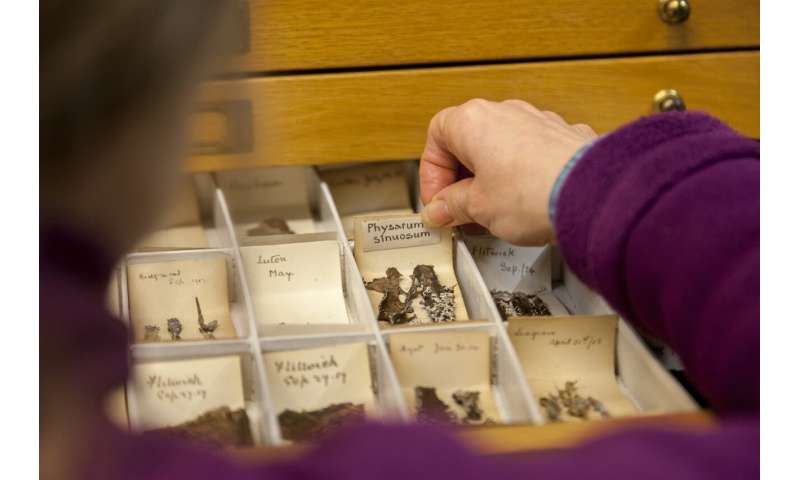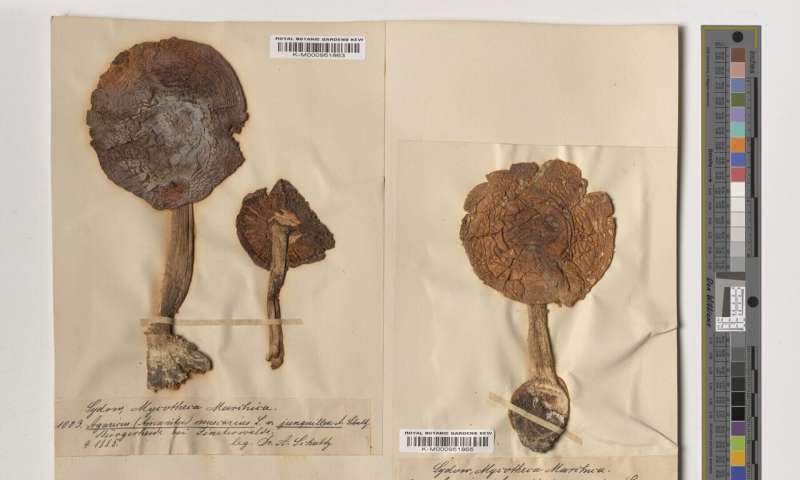Royal Botanic Gardens, Kew and Natural History Museum announce groundbreaking mycological research programme

The Royal Botanic Gardens, Kew (RBG Kew) and the Natural History Museum, London (NHM), are set to spearhead a groundbreaking initiative to reveal the vast diversity of fungi and lichens and the roles they play in our wild ecosystems and human-altered landscapes. This will enable experts to explore their potential uses in addressing some of the most pressing problems facing humanity.
Kew's Fungarium collection and the NHM's lichen collection are both the largest of their kind in the world, but little is known about the biology of many of the specimens they hold. Sequencing the genomes of thousands of these, and deciphering their genetic code, will allow scientists to understand the landscape of fungal diversity and unlock its potential for medicine, agriculture, and environmental restoration.
Fungi, often inconspicuous and hidden from our view, play a pivotal role in maintaining life on Earth. Essential components of ecosystems, they silently orchestrate critical environmental processes, such as recycling nutrients and sequestering carbon, that impact us all. They are the source of life-saving drugs, are used in biofuel production, and some species can even help to clean up our environment. Fungi in the genus Penicillium have diverse uses in the antibiotic industry, in the synthesis of third-generation contraceptive pills, and in cheese production. But fungi are not always beneficial to humans: up to 30% of global crop products, enough food to feed 600 million people, are destroyed each year by fungi and fungus-like organisms called oomycetes.
Lichens are miniature ecosystems made up of a fungus and algae and/or cyanobacteria. They can be used to monitor the number of pollution particles in the air and the effects of air pollution on ecosystems. Researchers can use lichens to diagnose and predict how air pollution is changing ecological communities and agricultural systems and what that might mean for ecosystem functioning or crop health.
Yet, the vast diversity of fungi is understudied and there is a huge amount that is still unknown. There are around 160,000 known species of fungi, but this is only a small fraction of the 2.5 million species estimated to exist. Identifying fungi based on morphology alone can be challenging and ambiguous, so DNA sequences provide important reference data and can yield new insights. This project is set to systemise our knowledge and reveal where the gaps in it lie, challenge existing interpretation, and provide a radically reshaped understanding of fungal life.
Dr. Ester Gaya, Senior Mycologist at RBG Kew said, 'We're very excited about this much-needed investment into mycology research. Fungi are essential components of all ecosystems and underpin most life on Earth. However, despite their importance and industrial focus on a handful of useful species, the vast diversity of fungi has been hugely understudied compared with plants and animals and we only know less than 10% of fungi species believed to exist. This new funding will enable us to characterise our incredible fungal collection at a molecular level, which will transform the way we identify fungi and understand how they're related, and provide a window into the past that will shed a light into how pathogens and other fungal lifestyles have evolved through time.'
Dr. Tim Littlewood, Executive Director of Science at the NHM said, 'The natural world is in trouble and biodiversity is in decline. To protect our planet, we must understand the different organisms we share it with. The opportunity to DNA-sequence the world's largest lichen collection at our cutting-edge labs is an innovative way to monitor nature and understand biodiversity and ecosystem function. Genomics is one of our ten research themes aiming to find solutions from and for nature for some of the biggest global challenges.'

Unique collections:
Kew's Fungarium houses over 1.25 million specimens from around the world, including 50,000 type specimens (the original reference material that is used to make a definitive link between a fungus as a living organism and the name applied to it). It stands as the largest and most comprehensive fungal collection globally, with many specimens exclusive to Kew. These invaluable resources will be pivotal in advancing our understanding of fungi. The NHM's lichen collection is an important research resource and one of the world's largest, comprising 400,000 specimens, including 10,000 type specimens. Understanding more about their genetic make-up will support research projects that Museum researchers are involved in, such as investigating the effects of nitrogen air pollution on tea plantations in Sri Lanka, using lichens as indicators.
Working together to safeguard biodiversity:
This research funding marks a major step forward for a new biodiversity alliance between three world-leading organisations based in the UK: RBG Kew, NHM and Zoological Society of London (ZSL). The alliance will bring together collective expertise towards a common goal—to halt biodiversity loss and help set our societies on a nature-positive trajectory. This will be achieved through science-led innovation to support delivery of the Kunming-Montreal Global Biodiversity Framework, the Paris Agreement on climate change, and the UN's Sustainable Development Goals.
Professor Alexandre Antonelli, Director of Science at RBG Kew said, 'This is an exciting, timely and transformational investment. It will not only bring direct benefits to the UK—by increasing our ability to rapidly detect new fungal diseases affecting our crops and ecosystems, allowing us to monitor the health of our soils, and speeding up the documentation of the country's fungal diversity—but also constitutes an invaluable resource for advancing global fungal research, conservation and sustainable use.
'In parallel to this work, the ongoing digitisation of Kew's Herbarium and Fungarium collections is creating a global online resource, freely accessible to researchers worldwide. Investments like this represent a leap toward understanding our planet's intricate web of life and safeguarding it for generations to come.'
Defra Chief Scientific Advisor, Professor Gideon Henderson, said, 'Fungi are an essential part of our ecosystem and play a vital role in maintaining life on earth. It is crucial we unlock and harness their potential to enhance our biosecurity, medicinal needs, agriculture and environmental restoration.
'This important new research programme, supported by Defra, will help these world-leading organisations provide important insight into fungal life. The knowledge generated in this programme will underpin new scientific discoveries, innovative services, and economic growth building on the UK's world-leading fungal collections and biosciences community.'
Provided by Royal Botanic Gardens, Kew